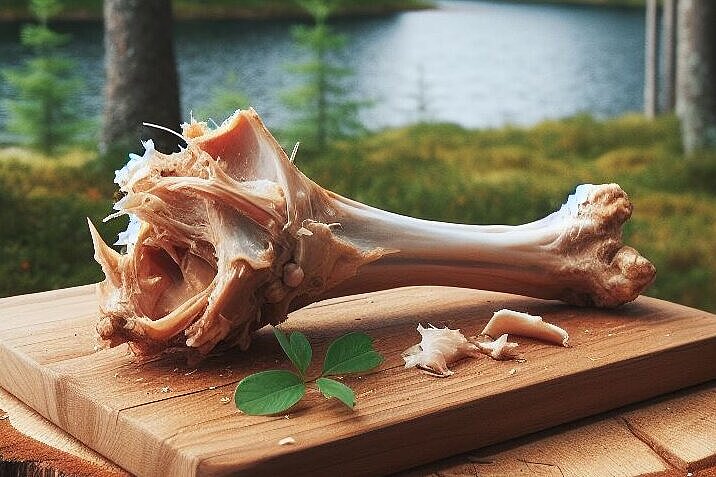Goose thigh bone

The nutrition and well-being of our dogs is important to us. In our quest to offer them varied and exciting chews, we sometimes come across unusual options, such as goose leg bones. While the idea of giving your dog such a treat may be tempting, it's important to look carefully at the potential pros and cons. In this article, we'll explore whether goose thigh bones can be a suitable addition to your dog's diet by analyzing their properties, potential health benefits and associated risks in detail.
What are goose thigh bones?
Goose thigh bones are the hard structures that form the lower part of a goose's leg. After the meat has been removed for human consumption, the bones often remain, which at first glance appear to be a potential chew for dogs. These bones are rich in minerals and, when raw, can be a source of certain nutrients.
Benefits of goose thigh bones for dogs
Dental health
Chewing on bones can help clean teeth by helping to reduce plaque and tartar. This supports overall oral hygiene and can reduce the risk of dental disease.
Occupation
Chewing provides a natural and satisfying activity for dogs that contributes to mental stimulation and prevents boredom.
Source of nutrients
Raw bones can be a source of minerals such as calcium and phosphorus, which are important for bone health.
Disadvantages and risks
Risk of injury
Cooked or grilled goose thigh bones can splinter and form sharp edges that can injure the dog's mouth, esophagus or digestive tract. Even raw bones can pose a choking risk if they are too small.
Fat content
Goose thighs are often high in fat, and the fat may still be on the bones. High fat content can lead to obesity and pancreatitis in dogs.
Nutrient imbalance
Excessive feeding of bones can lead to an imbalance in the diet, especially if there is an excessive intake of calcium compared to other nutrients.
Bacterial contamination
Raw bones can be contaminated with bacteria such as salmonella, which can pose a health risk to both the dog and the people in the household.
While goose thigh bones may seem like an attractive addition to your dog's diet at first glance, the potential risks and disadvantages outweigh the benefits. The risk of injury from splintering bones, the risks associated with high fat content and bacterial contamination, and the possibility of nutritional imbalance make them a less recommended option. If you want to give your dog a treat, there are safer alternatives that are specifically designed for chewing and won't put your dog's health at risk.
If you notice any signs of hypersensitivity or poisoning in your dog, you should see your vet immediately. We are not a substitute for a vet, but we try to be as accurate as possible. Every dog reacts differently and we recommend you get a second opinion or consult your vet if in doubt.
Stay healthy and take good care of your four-legged friend!😊
Similar to Goose thigh bone
Duck thigh bones are exactly what their name suggests: the bones from the thighs of ducks. They can be offered raw, cooked or dried and are considered a tasty and nutritious addition to regular dog...
Chicken thigh bones are the bones from the lower part of the chicken leg. They consist of a long tubular bone and a short jointed bone. The bones are surrounded by meat, skin and cartilage. Chicken...
Pigeon thigh bones are, as the name suggests, the bones from the thighs of pigeons. They are usually found in dogs' diets as part of a raw meat diet (BARF - Biologically Appropriate Raw Food). Their...
Turkey thigh bones are the bones found in the lower part of the turkey leg, an area known for its dark, flavorful meat. While the meat is a popular source of protein, the bones themselves draw a...


